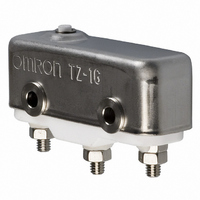TZ-1G Omron, TZ-1G Datasheet - Page 4

TZ-1G
Manufacturer Part Number
TZ-1G
Description
HIGH TEMP Z SWITCH
Manufacturer
Omron
Series
TZr
Type
High-temperature Basic Switchr
Datasheet
1.TZ-1G.pdf
(6 pages)
Specifications of TZ-1G
Circuit
SPDT
Switch Function
On-Mom
Contact Rating @ Voltage
1A @ 250VAC
Actuator Type
Round (Pin Plunger)
Mounting Type
Chassis Mount
Termination Style
Screw Terminal
Contact Form
SPDT
Contact Rating
1 Amp at 250 Volts
Actuator
Plunger, Pin
Operating Force
500 g
Lead Free Status / RoHS Status
Lead free / RoHS Compliant
Operating Force
-
Lead Free Status / Rohs Status
Lead free / RoHS Compliant
Other names
SW759
TZ1G
TZ1G
Safety Precautions
Be sure to read the precautions and information common to all Snap Action and Detection Switches, contained in the Technical User’s Guide,
“Snap Action Switches, Technical Information” for correct use.
Precautions for Safe Use
Handling
The Switch has a ceramic casing. Do not drop the Switch from a
height of 30 cm or more. Doing so will break the casing.
• Connect nickel-plated solderless terminals to the TZ. Each terminal
• Make sure that the ceramic case is free of metal powder or other
Operation
• Do not modify the Actuator and change the operating position.
• Make sure that the switching speed is not extremely slow or do not
• Make sure that the pin plunger and the switching stroke are on the
• Make sure that the switching frequency or speed is within the
1. If the switching speed is extremely slow, the contact may not be
2. If the switching speed is extremely fast, switching shock may
• Make sure that the actuator travel does not exceed the permissible
Precautions for Correct Use
Mounting Location
• Do not use the switch alone in atmospheres such as flammable or
• Switches are generally not constructed with resistance against
• Install the switch in a location that is not directly subject to debris
120
must be secured on the TZ with M3.5 nut.
impurities.
use the Switch so that the pushbutton will be set to a position
between the FP and OP.
same vertical line.
specified range.
OT position. The operating stroke must be set to 70% to 100% of
the rated OT.
explosive gases. Arcing and heat generation associated with
switching may cause fires or explosions.
water. Use a protective cover to prevent direct spraying if the switch
is used in locations subject to splashing or spurting oil or water,
dust adhering.
and dust from cutting. The actuator and the switch body must be
protected from accumulated cutting debris and dirt.
switched smoothly, which may result in a contact failure or contact
welding.
damage the Switch soon. If the switching frequency is too high,
the contact may not catch up with the speed.
The rated permissible switching speed and frequency indicate the
switching reliability of the Switch.
The life of a Switch is determined at the specified switching
speed. The life varies with the switching speed and frequency
even when they are within the permissible ranges. In order to
determine the life of a Switch model to be applied to a particular
use, it is best to conduct an appropriate durability test on some
samples of the model under actual conditions.
Incorrect
High-temperature Basic Switch
Terminal box
Incorrect
Terminal box
Correct
Correct
TZ
• Do not use the switch in locations subject to hot water (greater than
• Do not use the switch outside the specified temperature and
• Mount a cover if the switch is to be installed in a location where
• Subjecting the switch to continuous vibration or shock may result in
• If silver contacts are used with relatively low frequency for a long
• Do not use the switch in atmospheres with high humidity or heat or
• The switch includes contacts. If the switch is used in an atmosphere
60°C) or in water vapor.
atmospheric conditions.
The permissible ambient temperature depends on the model.
(Refer to the specifications in this catalog.) Sudden thermal
changes may cause thermal shock to distort the switch and result
in faults.
worker inattention could result in incorrect operation or accidents.
contact failure or faulty operation due to abrasion powder and in
reduced durability. Excessive vibration or shock will cause the
contacts to operate malfunction or become damaged. Mount the
switch in a location that is not subject to vibration or shock and in a
direction that does not subject the switch to resonance.
time or are used with microloads, the sulfide coating produced on
the contact surface will not be broken down and contact faults will
result. Use a microload switch that uses gold contacts.
in harmful gases, such as sulfide gas (H
(NH
impair functionality, such as with damage due to contacting faults or
corrosion.
with silicon gas, arc energy may cause silicon oxide (SiO
accumulate on the contacts and result in contact failure. If there is
silicon oil, silicon filling, silicon wiring, or other silicon products in
the vicinity of the switch, use a contact protection circuit to limit
arcing and remove the source of the silicon gas.
Incorrect
3
Incorrect
), nitric acid gas (HNO
3
), or chlorine gas (Cl
(preventing malfunctions)
Correct
Correct
2
S, SO
2
2
), ammonia gas
). Doing so may
Separate the
installation
location from
heat sources.
2
) to








